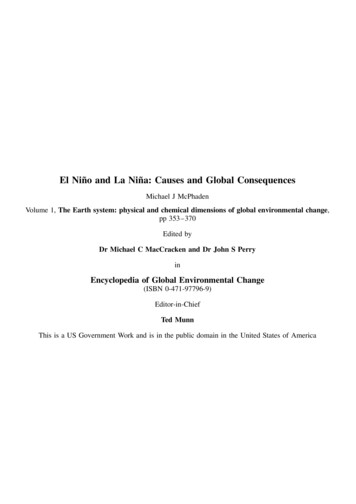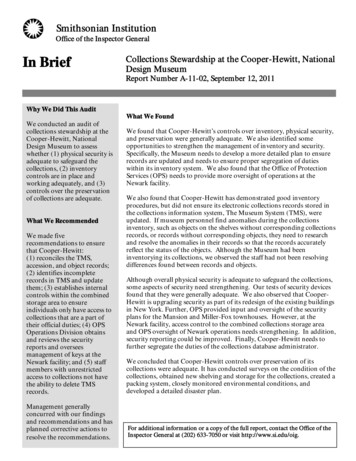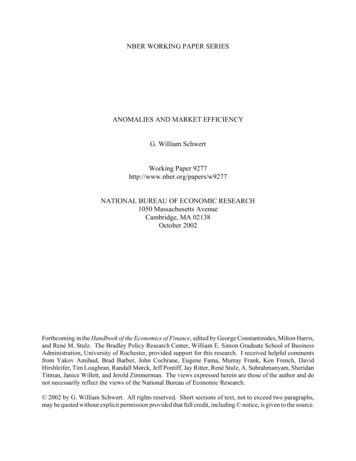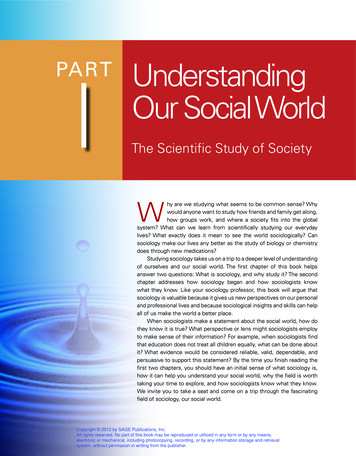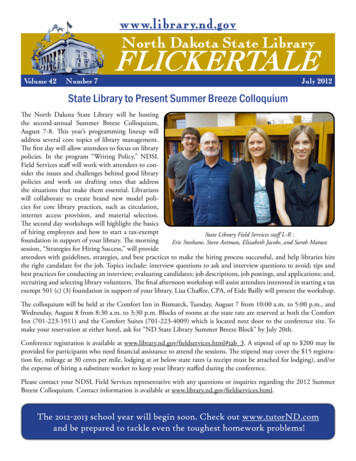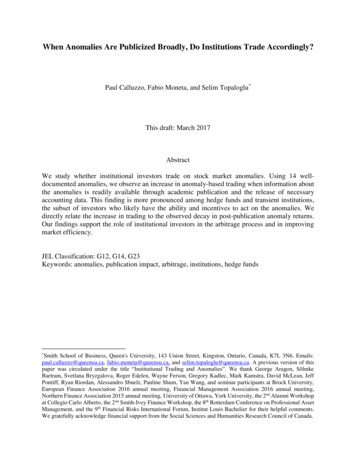
Transcription
When Anomalies Are Publicized Broadly, Do Institutions Trade Accordingly?Paul Calluzzo, Fabio Moneta, and Selim Topaloglu*This draft: March 2017AbstractWe study whether institutional investors trade on stock market anomalies. Using 14 welldocumented anomalies, we observe an increase in anomaly-based trading when information aboutthe anomalies is readily available through academic publication and the release of necessaryaccounting data. This finding is more pronounced among hedge funds and transient institutions,the subset of investors who likely have the ability and incentives to act on the anomalies. Wedirectly relate the increase in trading to the observed decay in post-publication anomaly returns.Our findings support the role of institutional investors in the arbitrage process and in improvingmarket efficiency.JEL Classification: G12, G14, G23Keywords: anomalies, publication impact, arbitrage, institutions, hedge funds*Smith School of Business, Queen's University, 143 Union Street, Kingston, Ontario, Canada, K7L 3N6. Emails:paul.calluzzo@queensu.ca, fabio.moneta@queensu.ca, and selim.topaloglu@queensu.ca. A previous version of thispaper was circulated under the title “Institutional Trading and Anomalies”. We thank George Aragon, SöhnkeBartram, Svetlana Bryzgalova, Roger Edelen, Wayne Ferson, Gregory Kadlec, Mark Kamstra, David McLean, JeffPontiff, Ryan Riordan, Alessandro Sbuelz, Pauline Shum, Yan Wang, and seminar participants at Brock University,European Finance Association 2016 annual meeting, Financial Management Association 2016 annual meeting,Northern Finance Association 2015 annual meeting, University of Ottawa, York University, the 2nd Alumni Workshopat Collegio Carlo Alberto, the 2nd Smith-Ivey Finance Workshop, the 8th Rotterdam Conference on Professional AssetManagement, and the 9th Financial Risks International Forum, Institut Louis Bachelier for their helpful comments.We gratefully acknowledge financial support from the Social Sciences and Humanities Research Council of Canada.
1. IntroductionFinance and accounting literature has documented more than 330 variables that predictfuture stock returns (Green et al., 2013).1 However, while the anomalies look great on paper,McLean and Pontiff (2016) show that once the anomalies are published, the returns associatedwith them decline by more than 50%. The authors discuss two potential explanations for the postpublication decline in anomaly returns: 1) anomalies are the result of statistical biases that will notpersist out of sample; or 2) they are due to mispricing that is corrected by arbitrageurs.Institutional investors are prime candidates for the role of arbitrageurs as they are generallyperceived to be sophisticated, and have an increasing presence in the U.S. equity market with a63.8% ownership stake at the end of 2013. If institutions are indeed arbitrageurs then themispricing explanation predicts that they will trade on anomalies. However, Lewellen (2011) findsthat institutions show little tendency to bet on anomalies and Edelen, Ince, and Kadlec (2016,henceforth EIK) report that institutions trade in the opposite direction of anomalies. These findingssuggest that either the anomalies are the result of statistical biases, not mispricing, or thatinstitutions do not act as arbitrageurs.Despite recent evidence, we posit that institutions can indeed act as arbitrageurs and correctanomaly mispricing. However, to fulfill this role, they need to know about the anomaly and havethe ability or incentives (or both) to act on the information. Specifically, we consider: 1) if theknowledge of the anomaly is in the public domain based on the year of academic publication; 2)if the accounting data necessary to compute the anomaly rankings is publicly available; and 3) ifthere is heterogeneity among institutions with respect to information processing, and the incentivesto act on their information. To the best of our knowledge, this is the first paper to considerinstitutional trading on anomalies along these three dimensions, which will help us directly observeinstitutions’ role as arbitrageurs.1The returns associated with these variables are often called anomalies because they cannot be explained by traditionalasset-pricing models (e.g., the Capital Asset Pricing Model of Sharpe (1964) and Lintner (1965), and the three-factormodel of Fama and French (1993)). For a review of the literature see Subrahmanyam (2010).1
Financial media and industry-oriented journals have long disseminated academic researchto practitioners, which suggests that at least some practitioners condition their trading strategieson published academic findings. For example, consider the case of Dimensional Fund Advisors(DFA), which had 381 billion in assets under management (AUM) as of December 2014. DFAemploys a group of ‘academic leaders’, including three Nobel laureates and several other topacademic scholars. On its website, DFA emphasizes “bringing research to the real world” with itsincorporation of stock selection screens based on academic research.2 Additionally, Pastor et al.(2015) find that younger fund managers outperform their older peers. This finding may be relatedto young managers who, having just graduated, use the latest academic research they absorbed atschool to beat the market.3 However, there is scant empirical evidence of institutional investorsactually trading on published research. To address this gap, we study the trading behavior ofinstitutional investors in 14 well-documented anomalies to determine if they exploit the anomaliesand help bring stock prices closer to efficient levels.4Our identification strategy focuses on the period when the anomaly is first published in theacademic literature. We view journal publication as a shock that increases knowledge of theexistence and profitability of the strategy among arbitrageurs without directly affecting thefundamentals that drive anomaly profits. Examining the changes in both institutional tradingactivity and anomaly profits around publication enables us to identify the arbitrageurs and theimpact of their trading on anomaly returns. In particular, we test the hypothesis that as institutions’awareness about the anomalies increases there is a rise in anomaly-based trading and a subsequentattenuation of the anomaly profits.See DFA’s “Philosophy / Research” webpage at . DFA is notalone in their emphasis on academic credentials. Other institutional investors with strong academic ties include (butare not limited to) AQR Capital Management ( 136 Billion AUM), LSV Asset Management ( 89 Billion AUM), andResearch Affiliates ( 67 Billion AUM).3See an interview of Lubos Pastor in CNN Money: “New mutual funds better than older ones?” Retrieved g-old-mutual-funds.4The 14 anomalies are net stock issues, composite equity issues, total accruals, net operating assets, gross profitability,asset growth, capital investments, investment-to-assets, book-to-market, momentum, distress, Ohlson O-score, returnon assets, and post-earnings announcement drift (see Table 1 for details).22
To test our hypothesis, each year we rank stocks according to each of our 14 ‘anomalyvariables’ (i.e., the variables that have been shown to predict future stock returns) and build longand short portfolios (legs) using the top and bottom quintiles.5 We measure institutional trading bycomputing changes in aggregate institutional holdings in the long and short portfolios of eachanomaly. We focus on the window for which the accounting information necessary to constructthe anomaly rankings is publicly available. We examine trading across our full sample period(1982-2013), as well as before and after publication, to test whether institutions follow academicresearch. Given the relatively large number of anomalies considered in this paper, and sinceinstitutions are likely to trade on multiple signals at the same time, we also examine two aggregateportfolio strategies that combine rankings across our sample of anomalies: an ‘ex-post’ portfoliothat ranks stocks based on anomalies that have already been published; and an ‘ex-ante’ portfoliothat ranks stocks based on anomalies that are yet to be published. Finally, we use a vectorautoregressive (VAR) model to test our prediction that anomaly-based trading by institutions leadsto the post-publication decay in anomaly returns.Throughout our analysis, in addition to examining the full set of institutions, we alsoconsider anomaly-based trading by different institution types. There may be heterogeneity in theincentives institutions face to act on information. For example, hedge funds are the leastconstrained among institutional investors and have a compensation structure that can encouragerisk-taking behavior (e.g., Goetzmann et al., 2003). Moreover, institutions may differ in theirability to process information (e.g., Yan and Zhang, 2009). These differences may, in turn, affectthe extent to which institutions exploit anomalies. We therefore examine trading among subgroupsthat may be better positioned to take advantage of the anomalies: hedge funds, mutual funds, andtransient institutions.65Because real-world investors may update their information set about the anomaly variables on a more frequent basisthan annually, we also construct a quarterly version of each anomaly using the most up-to-date data available at theend of each quarter. All our tables include results for both the annual and quarterly ranked anomalies.6Transient institutions, as identified by Bushee (2001), are active investors whose portfolios exhibit high turnover.Ke and Ramalingegowda (2005) document that transient institutions are active in exploiting the post-earningsannouncement drift anomaly.3
Our results verify that trading with the anomaly is profitable in the original sample period,and, consistent with McLean and Pontiff (2016), we observe a decay in anomaly returns in theperiod after publication. When we examine anomaly-based trading in the full sample period,consistent with Lewellen (2011) and EIK, we find that, in aggregate, institutional investors do nottake advantage of stock return anomalies. However, this result is driven by trading in the periodbefore publication and it is due to the focus on aggregate institutional trading. In the four yearsafter publication, there is a significant increase in anomaly-based trading, which suggests thatinstitutions do try to exploit the anomalies and their timing is related to the journal publicationthereof. When we focus on the hedge fund and transient institution subgroups, we find that thetiming of their trading coincides with and even anticipates the journal publication of the anomalies.We observe a weaker relation between publication and anomaly-based trading for mutual funds.We next examine institutional trading and returns in the ex-ante and ex-post portfolios.Consistent with an increase in anomaly-based trading after publication, institutional trading islarger in the ex-post portfolio, especially among hedge funds and transient institutions. We thenperform Granger-causality tests to determine the causality between institutional trading andreturns, and find a significant negative relation between institutional trading and future anomalyreturns in the ex-post portfolio. In contrast, we find no significant relation between institutionaltrading and future returns in the ex-ante portfolio. These results suggest that institutional tradingand anomaly publication are integral to the arbitrage process which helps bring prices to a moreefficient level.We conduct a series of tests to ensure the robustness of our results. First, to control forcommon determinants of institutional trading, we examine stock-level institutional trading in theex-ante and ex-post portfolios using Fama-MacBeth cross-sectional regressions. We findconsistent results for the long and short portfolios: there is a significant increase (decrease) ininstitutional trading in the long (short) leg of the ex-post portfolio vs. ex-ante portfolio. Second, tofurther understand the drivers of our results, we separately examine trading and returns in the longand short legs of the anomaly portfolios and find evidence consistent with increased trading and4
return decay after publication in both legs. Third, to address concerns about our anomaly selection,we confirm that our main results are similar, and in some cases stronger, for various subsets of ouranomalies. Finally, we find that our main results are robust to various alternative specificationsincluding: using SSRN posting dates instead of publication dates; including year and anomalyfixed effects in our trading regressions; controlling for the financial crisis; using differentdefinitions to construct the ex-ante and ex-post portfolios; controlling for liquidity in the VARanalysis; and examining short sales using short-interest data.The main contribution of our paper is to show that institutions trade on anomalies wheninformation about the anomalies is readily available to investors through academic publication andthe release of necessary accounting data. To reconcile our results with EIK, we examineinstitutional trading at times when the information about the anomalies may not be readilyavailable. Specifically, we consider trading in the period prior to academic publication and in thewindow when the information needed to compute the anomaly rankings may not be available, andfind no evidence of anomaly-based trading by institutions.7 Further, we examine trading for agroup of institutions that are neither hedge funds nor transient, and thus may not have the abilityor the incentive to implement anomaly strategies. We find that these investors trade againstanomalies, and may be a source of the contrarian trading documented by EIK. This result isconsistent with both agency-induced preferences that are contrary to anomaly-based signals, andsome institutions potentially playing a causal role in the anomalies.This paper adds to the strand of research that investigates institutional trading and marketefficiency. We assess whether institutions implement trading strategies to exploit anomalies andprovide evidence that this behavior mainly occurs after anomaly publication. We relate this7A key difference between EIK and our paper is that their trading window starts four quarters before our window,when the anomaly variables are being realized, whereas our window starts when most of the accounting informationis publically available. Another difference is that we measure trading using the value-weighted change in holdings,while EIK use the change in number of institutions holding a stock and the equal-weighted change in holdings. In theresults section, we show that when we use these alternative measures our main results hold. When we examine tradingbefore publication and the availability of the accounting information, consistent with EIK, we find evidence thatinstitutions trade against the anomalies.5
evidence to the attenuation of the anomalies documented by McLean and Pontiff (2016) andprovide evidence more consistent with the mispricing explanation than statistical biases. Ourfindings suggest a positive role for some institutions in contributing to more efficient markets. 8 Inline with Grossmann and Stiglitz (1980), efficient security prices require market participants toactively trade on relevant information driving security prices toward the ‘true’ price.This paper also contributes to the hedge fund literature. Since the collapse of Long-TermCapital Management in 1998, hedge funds have been the target of increased scrutiny by regulatorsand the financial press.9 We find that our results are strongest among hedge funds and transientinstitutions: they actively trade on the anomalies and correct mispricing. This finding is importantas it contributes to a better understanding of the role of hedge funds and transient institutions asarbitrageurs.We also add to the debate, initiated by Fama (1976), regarding the nature of informationthat institutions possess. Our paper suggests that institutions learn from academic research byadopting trading strategies based on published findings. This analysis is therefore relevant forunderstanding the value and impact of financial academic research. Furthermore, the finding thatinstitutions trade on the anomalies only when they have the necessary accounting data, rather thanwhen the anomaly variables are being realized, suggests that institutions are limited in their abilityto anticipate information relevant to the anomaly rankings. Finally, the documented heterogeneityin the level of anomaly-based trading across institutions indicates that institutions may differ intheir incentives and abilities to process information.8Kokkonen and Suominen (2015) and Akbas et al. (2015) provide recent complementary evidence that hedge fundsimprove stock market efficiency. One concern is that the increase in institutional trading after publication may increasecrash risk if institutions follow similar strategies and exit them at the same time. Although we cannot exclude thispossibility, the fact that anomaly-based trading is highest early in the post publication period and then attenuates, helpsalleviate this concern.9In 2004, the Securities and Exchange Commission (SEC) tried to increase the regulation of hedge funds by issuinga rule that required all hedge funds to register with the SEC. This rule was challenged and rejected by the U.S. Courtof Appeals.6
2. Related LiteratureOur paper is related to the literature on stock market efficiency and anomalies. Theliterature highlights three explanations for the existence of the anomalies. First, several papersargue that anomalies are driven by various statistical biases, such as sample selection bias(Heckman, 1979), data snooping bias (Lo and MacKinlay, 1990), simple chance (Fama, 1998), orconsideration of an inappropriate significance cutoff that does not take into account multiple tests(Harvey et al., 2015). Second, some papers explain the existence of anomalies as compensationfor risk consistent with asset pricing models. For example, Fama and French (1996) argue that thesize and value anomalies could reflect exposure to macroeconomic risk factors. Sadka (2006)considers liquidity risk as a missing factor that could explain part of the abnormal returnsassociated with momentum and post-earnings-announcement drift. Finally, anomalies could bedue to mispricing (e.g., Barberis and Thaler, 2003) and present investment opportunities.If statistical biases explain anomalies we do not expect investors to react and trade on them.Cochrane (1999) discusses investor reactions to risk-based and mispricing-based anomalies. Heargues that if an anomaly is based on risk, investors will not trade on it and the high average returnwill persist, whereas if an anomaly is driven by mispricing and is easy to trade on, then “the averageinvestor will immediately want to invest when he hears of the opportunity. News travels quickly,investors react quickly, and such opportunities vanish quickly.” However, there is a debate aboutwhether anomaly-based trading strategies are profitable after accounting for transaction costs (e.g.,Knez and Ready, 1996; Lesmond et al., 2004), and whether investors are able to exploit themispricing given the limits of arbitrage (Shleifer and Vishny, 1997) or short-sale constraints.10Another relevant strand of literature examines the role of institutional investors in the pricediscovery process. In particular, some studies investigate whether institutional investors contributeto market efficiency (e.g., Boehmer and Kelley, 2009). Given that there are a large number ofanomalies that earn large excess returns, and some of them appear to be persistent across time10Stein (2009) also points out that crowding and leverage may create negative externalities that limit the arbitrageprocess.7
(e.g., Jegadeesh and Titman, 2001; Fama and French, 2008), institutional investors could try totrade mispriced securities. However, there is limited evidence of institutional investors trying tosystematically exploit anomalies.11 For example, few investors trade on and profit from theaccruals anomaly (Ali et al., 2008). There is also evidence that investors contribute to someanomalies: institutions tend to buy growth stocks and sell value stocks contributing to the valuepremium (Chan et al., 2002; Frazzini and Lamont, 2008; Jiang, 2010). Institutions may also findit optimal to herd with the rest of the market, pushing asset prices away from fundamental values(e.g., Griffin et al., 2011).Lewellen (2011) examines institutional holdings and finds that institutions as a whole donot act as arbitrageurs.12 In contrast to Lewellen’s paper, we focus on trading decisions thatrepresent a more direct signal of institutional reaction to information than the level of institutionalholdings. We also consider the time-variation in institutional trading and how it is related to theawareness of the anomalies. Moreover, in this paper we focus on the most active institutions: hedgefunds and transient institutions.13 We show that these institutions actively trade to exploit theanomalies. In contrast, we find weaker results when we examine whether mutual funds trade onthe anomalies. This analysis is important for the literature that examines the investment ability andperformance of hedge funds and mutual funds.14Finally, some recent papers examine whether practitioners learn about potential tradingopportunities from academic research, in particular in the context of return predictability. Thereare conflicting findings in this literature. On the one hand, Johnson and Schwartz (2000), similarto McLean and Pontiff (2016), report that the post-earnings-announcement drift was eliminated11There is evidence that some institutional investors try to exploit a specific anomaly. For example, they tend to followmomentum strategies (Grinblatt et al., 1995) and trade on the post-earnings-announcement drift (Ke andRamalingegowda, 2005; Ali et al., 2012).12See Hwang and Liu (2014) for a recent study on short-selling activity of arbitrageurs.13Lewellen (2011) aggregates institutions classified as investment companies, investment advisors, and otherinstitutions.14There is a large literature on mutual funds and hedge funds. For a review of the mutual fund literature see Aragonand Ferson (2006). For a review of the hedge fund literature see Fung and Hsieh (2006).8
once the anomaly was documented in academic research.15 As mentioned previously, thisobservation would be consistent with both statistical biases and the possibility that academicresearch is attracting the attention of sophisticated investors who trade against the mispricing.Neither paper examines institutional trading. Without analyzing trading it is hard to tell whichinterpretation is correct. On the other hand, EIK find that institutions trade in the opposite directionof anomalies. Furthermore, Richardson et al. (2010) present survey evidence that showspractitioners read few published academic papers and pay little attention to working papers.3. DataWe use Compustat and CRSP to obtain the accounting and financial data needed toreplicate the anomalies. We consider a set of 14 well-documented anomalies (see Table 1): netstock issues, composite equity issues, total accruals, net operating assets, gross profitability, assetgrowth, capital investments, investment-to-assets, book-to-market, momentum, distress (failureprobability), Ohlson O-score, return on assets, and post-earnings announcement drift (as measuredby standardized unexpected earnings).16 Eleven of these anomalies are studied by Stambaugh etal. (2012) and three additional anomalies (capital investments, book-to-market, and post-earningsannouncement drift) are included to be consistent with recent literature (e.g., Chen et al., 2011).These anomalies are important because, with the exception of book-to-market, they are notexplained by the widely used three-factor Fama-French model. Our main sample includes U.S.common stocks traded on the NYSE, AMEX, and NASDAQ from January 1982 to December2013 (June 2014 for stock returns). We exclude utilities, financial firms, and stocks priced under 5. We compute quarterly cumulative returns using data from the CRSP monthly files.15Chordia et al. (2014) find that several anomalies have attenuated significantly over time. However, they do notexamine if this is due to specific trading behavior of institutional investors. Green et al. (2011) also document asignificant reduction in the accrual anomaly, but they do not examine institutional trading either.16The Ohlson O-score was introduced by Ohlson (1980), but the profitability of a strategy based on this measure wasshown by Dichev (1998). That is why we use 1998 as the publication date.9
The Thomson Reuters (TR) 13F database is used to measure institutional trading.Institutional investors that exercise investment discretion over 100 million or more in Section13(f) securities are required to report to the SEC their end-of-quarter holdings on Form 13F within45 days of each quarter-end. TR has provided the equity positions of such institutions since 1980.We use the list from Griffin et al. (2011) that identifies hedge funds in 13F data, and update itusing the list compiled by Cella et al. (2013).17 We identify mutual funds as non-hedge fundinstitutions classified as an investment company or an independent investment advisor by BrianBushee’s website.18 We also identify transient institutions using the same source.19 Transientinstitutions are characterized as having high portfolio turnover and highly diversified portfolioholdings. We thus expect them to be active in exploiting anomalies. Table 1 reports the paper thatfirst documented each anomaly, its publication year, and the sample period used. The goal is toidentify the date when a research idea is introduced to the public domain. For simplicity we do notuse the publication month and assume that the papers were already public at the beginning of theyear. This assumption is realistic given the lag between manuscript acceptance and eventualpublication.We replicate the anomalies using the same sample period as the original paper thatidentified each anomaly. Following standard conventions in the literature, on June 30 th of year twe rank stocks into quintiles according to the anomaly variables and form long and short portfolios.The long portfolio contains underpriced securities that should be bought by arbitrageurs and theshort portfolio has overpriced securities that should be sold (short). To ensure that the accountingvariables necessary to construct anomaly rankings are known to investors, we use accounting data17We thank Andrew Ellul for kindly sharing this list.See ss.html. We checked the largest mutual fund families andthey were sometimes classified as an investment company and other times as an independent investment advisor.19Transient institutions comprise 18.6% of institutional holdings in our sample, hedge funds comprise 15.2% ofinstitutional holdings, and mutual funds comprise 41.4% of institutional holdings. The remainder of institutionalholdings are composed of ‘Other’ institutions such as pension funds, endowments, insurance companies, and banks.Mutual funds and hedge funds are mutually exclusive, whereas transient investors are composed of the most activehedge funds (34.5%), mutual funds (58.4%) and Other institutions (7.1%). 73.2% of hedge funds, 35.5% of mutualfunds, and 3.1% of Other institutions are transient on a value-weighted basis.1810
for the last fiscal year end in calendar year t – 1, most of which becomes available to marketparticipants by the end of March of year t.20 For each portfolio and for each anomaly, we computevalue-weighted raw and risk-adjusted portfolio returns over the following twelve months (fromJuly of year t to June of year t 1).Although most of the anomaly papers look at annually ranked anomalies, it is plausiblethat sophisticated investors update their information set about a security more frequently using themost recent available information. Presumably, this would be most relevant for anomalies thatwhose initial documentation in the academic literature used portfolios updated on a more frequentbasis. Therefore, we also construct a quarterly version of each anomaly. Specifically, we sortstocks at the end of each calendar quarter using the most up-to-date data at the beginning of eachquarter. This one-quarter gap is intended to ensure the data required to compute the anomalyvariables are publicly available. We then compute value-weighted raw and risk-adjusted returnsover the quarter following the sorting date. Given that we do not directly observe how ofteninstitutions update their information, throughout the paper, we present results for all the anomaliesin the annually and quarterly ranked portfolios.3.1 Summary StatisticsTable 2 Panel A presents correlations among portfolio ranks for our anomalies in additionto the first-order autocorrelation of each anomaly. Every June, we sort stocks into quintilesaccording to anomaly variables and compute the correlations. Consistent with Green et al. (2013),the anomalies are not strongly related to each other. Only 17 (4) out of 91 correlation coefficientshave an absolute value higher than 0.25 (0.50) and the average absolute value across all anomalypairs is 0.15, suggesting that each anomaly has its own distinct character. The low correlationsbetween book-to-market and momentum and the other anomalies ease concerns that our results in20For our annually constructed momentum ranking we use the six-month return with a three-month lag. In unreportedtests we find that our results are robust to va
Financial media and industry-oriented journals have long disseminated academic research . For example, consider the case of Dimensional Fund Advisors (DFA), which had 381 billion in assets under management (AUM) as of December 2014. DFA employs a group of 'academic leaders', including three Nobel laureates and several other top

